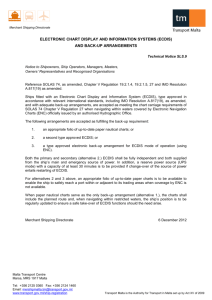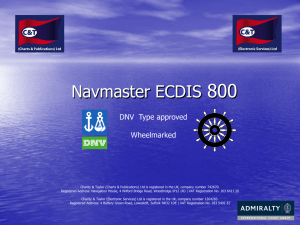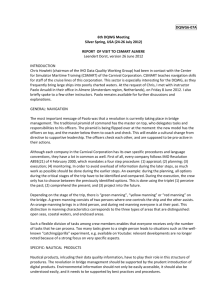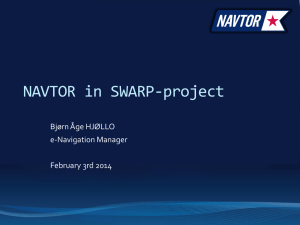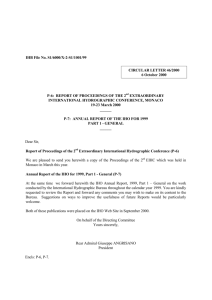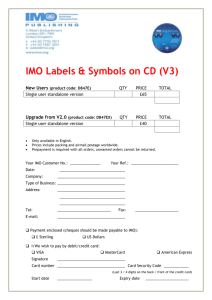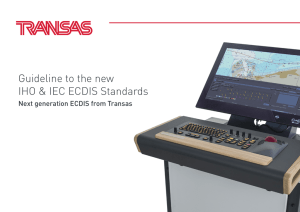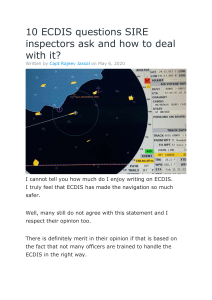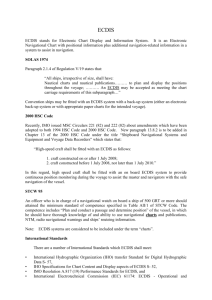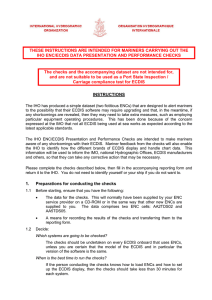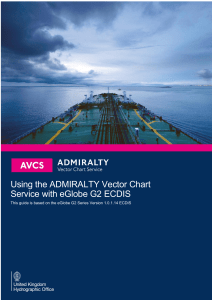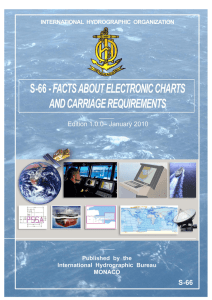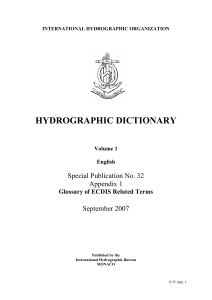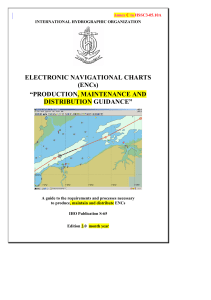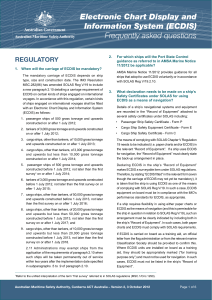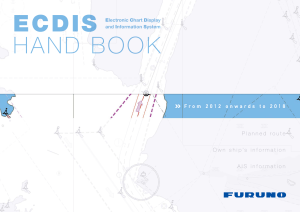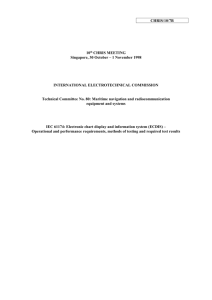ECDIS - RCDS – ENC
advertisement
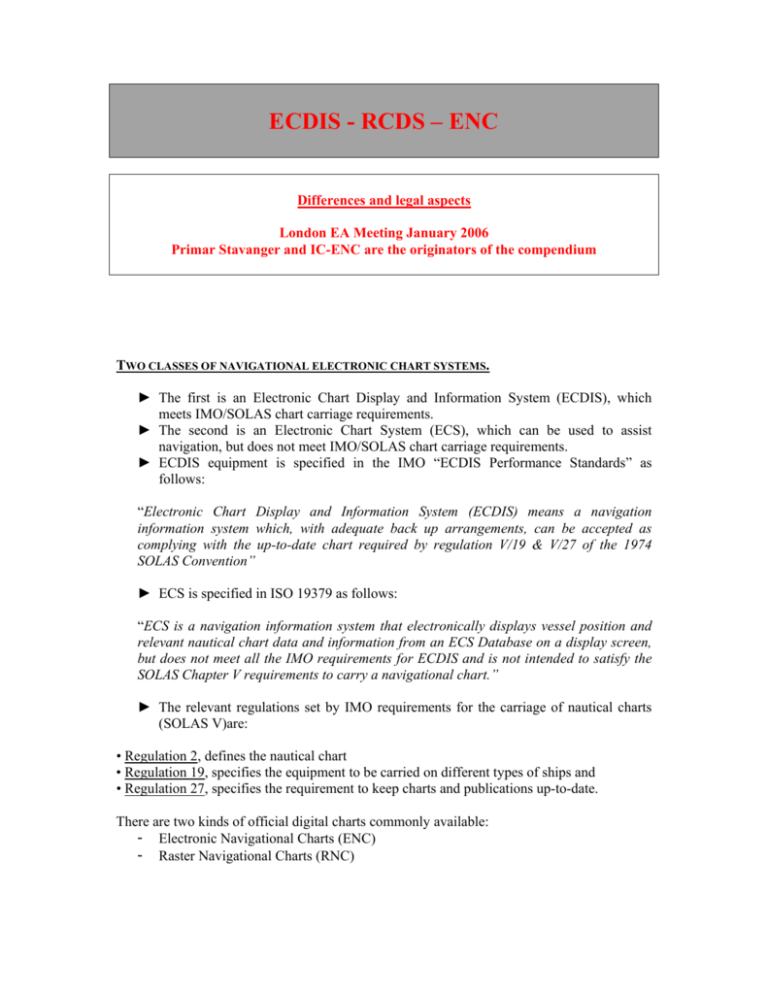
ECDIS - RCDS – ENC Differences and legal aspects London EA Meeting January 2006 Primar Stavanger and IC-ENC are the originators of the compendium TWO CLASSES OF NAVIGATIONAL ELECTRONIC CHART SYSTEMS. ► The first is an Electronic Chart Display and Information System (ECDIS), which meets IMO/SOLAS chart carriage requirements. ► The second is an Electronic Chart System (ECS), which can be used to assist navigation, but does not meet IMO/SOLAS chart carriage requirements. ► ECDIS equipment is specified in the IMO “ECDIS Performance Standards” as follows: “Electronic Chart Display and Information System (ECDIS) means a navigation information system which, with adequate back up arrangements, can be accepted as complying with the up-to-date chart required by regulation V/19 & V/27 of the 1974 SOLAS Convention” ► ECS is specified in ISO 19379 as follows: “ECS is a navigation information system that electronically displays vessel position and relevant nautical chart data and information from an ECS Database on a display screen, but does not meet all the IMO requirements for ECDIS and is not intended to satisfy the SOLAS Chapter V requirements to carry a navigational chart.” ► The relevant regulations set by IMO requirements for the carriage of nautical charts (SOLAS V)are: • Regulation 2, defines the nautical chart • Regulation 19, specifies the equipment to be carried on different types of ships and • Regulation 27, specifies the requirement to keep charts and publications up-to-date. There are two kinds of official digital charts commonly available: - Electronic Navigational Charts (ENC) - Raster Navigational Charts (RNC) WHAT IS AN OFFICIAL ENC? ► “ENC means the database, standardized as to content, structure and format, issued for use with ECDIS on the authority of government-authorized Hydrographic Offices.” ► “The ENC contains all the chart information useful for safe navigation, and may contain supplementary information in addition to that contained in the paper, which may be considered necessary for safe navigation”. Official ENCs have the following attributes: • ENC content is based on source data or official charts of the responsible Hydrographic Office; • ENCs are compiled and coded according to international standards; • ENCs are referred to World Geodetic System 1984 Datum (WGS84); • ENC content is the responsibility of the issuing Hydrographic Office; • ENCs are issued only by the responsible Hydrographic Office; and • ENCs are regularly updated with official update information distributed digitally. Official ENCs are vector charts compiled from a database of individual geo-referenced objects from Hydrographic Office’s archives including existing paper charts. The IHO Special Publication S-57 “IHO Transfer Standard for Digital Hydrographic Data” describes the standards to be used for the exchange of digital hydrographic data between national Hydrographic Office’s and for the distribution ► The presentation of official ENCs on the screen is specified in another IHO standard, the ”Colours and Symbols Specifications for ECDIS IHO S-52” ► ECDIS equipment is specified in the IMO ECDIS Performance Standards (IMOResolution A.817 (19)) as follows: ► “Electronic Chart Display and Information System (ECDIS) means a navigation information system which, with adequate back up arrangements, can be accepted as complying with the up-to-date chart required by regulation V/19 & V/27 of the 1974 SOLAS Convention, by displaying selected information from a system electronic navigational chart (SENC) with positional information from navigation sensors to assist the mariner in route planning and route monitoring, and by displaying additional navigation-related information if required.” ► To ensure that ECDIS equipment intended for onboard use is seaworthy, it must pass type approval and test procedures developed by the International Electrotechnical Commission (IEC) based on the ECDIS Performance Standards of IMO and applying the IHO requirements, S-52 and S-57 in particular. ► Type approval is normally conducted by recognized organisations or by marine classification societies nominated by Flag States. ► Some maritime nations also have type approval programs within their maritime safety administration or Department of Marine Transportation. What to do in areas without official ENC coverage? ► In 1998 the IMO recognised that it would take some years to complete the world’s coverage of ENCs. ► Introduced a new optional mode of operation of ECDIS, the Raster Chart Display System (RCDS)* ► => official ENCs where they were available and official RNCs to fill in the gaps. *see IMO Resolution A.817 (19) as amended; 1.9 and Appendix 7 IMO SN/Circ.207 ► IMO took note of the limitations of RNCs as compared to ENCs, and the revised ECDIS Performance Standards require that the ECDIS must be used together with “an appropriate folio of up-to-date paper charts” for the areas where RCDS mode is employed. Acceptance of ECDIS by port state control: ► A port state control Officer (PSCO) should assess whether a ship is using electronic charts in accordance with SOLAS requirements. ► The STCW (Standards of Training, Certification and Watch-keeping) and ISM (International Safety Management) codes put the responsibility firmly on the shipowner to ensure that mariners on their vessels are competent to carry out the duties they are expected to perform. (IMO course 1.27). What is ECS? ► An ECS may be able to use either official ENCs, RNCs or other chart data produced privately and could have functionality similar to ECDIS. ► Because ECS is not intended to meet SOLAS requirements, there are no IMO Performance Standards for ECS (by IHO). ► NB :The International Organisation for Standardization (ISO) has developed a Standard for ECS databases (=ECS Charts). Document ISO 19379. The Radio Technical Commission For Maritime Services (RTCM) has developed a recommended Performance Standard for ECS (=ECS Equipment). RTCM Paper 100-2002/SC109STD. None of these standards are recognized by the IMO. ENC Distribution ► The IHO developed the WEND (World-wide Electronic Navigational Chart Database) concept to provide a timely, reliable worldwide uniform ENC data distribution service ► WEND consists of two components: A charter describes the principles governing the cooperation between Hydrographic Offices A conceptual schema describes a network of regional centres. Regional Electronic Chart Co-ordinating Centre (RENC) RENC ► two RENCs : Primar Stavanger, based in Norway and IC-ENC, based in the United Kingdom, are in operation. ► A number of nations are still distributing their ENCs individually (e.g. Japan Hydrographic Office, Australian Hydrographic Office, USA - NOAA) RENC -> SENC ► IHO has issued the special publication S-63 “IHO Data Protection Scheme” as Standard for protection of ENCs by encryption. ► In order to get efficient data structures that facilitate the rapid display of ENC data, ECDIS firstly converts each ENC from S-57 ENC format into an internal format called SENC – System ENC – which is optimised for chart image creating routines. SENC DELIVERY ► This is in addition to the standard ENC distribution. ► In this case, the RENC delivers the ENCs to a chart data distributor who then performs the ENC-to-SENC conversion (that otherwise would have to happen inside the ECDIS), and deliver the SENCs to the end user. ENCs naming ► Each official ENC is identified by an 8 character identifier e.g. FR 501050. ► The first two characters = the producer e.g FR for France, GB for Great Britain (a complete list of producer codes is included in the IHO standard S-62). ► The third character (a number from 1 to 6) indicates the navigational purpose band (as shown in the table above). ► The last 5 characters are alpha- numeric and provide a unique identifier. Updating ENCs ► On data distribution media, e.g. CD; ► As e-mail attachment via SATCOM; and ► As broadcast message via SATCOM plus additional communication hardware. Rodolphe STRIGA
